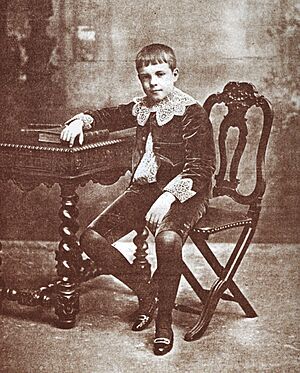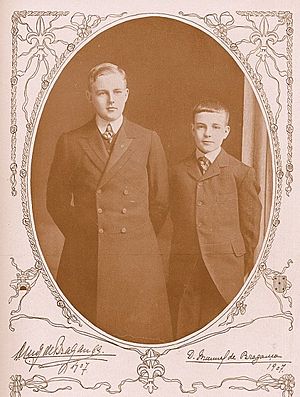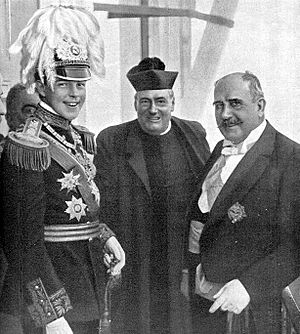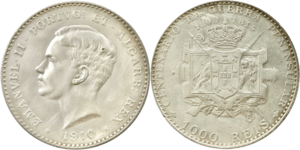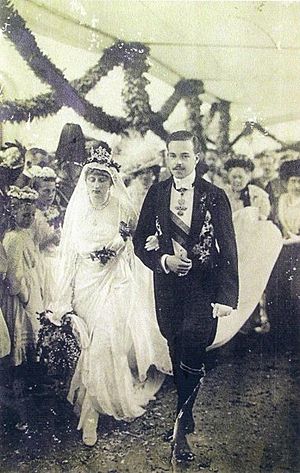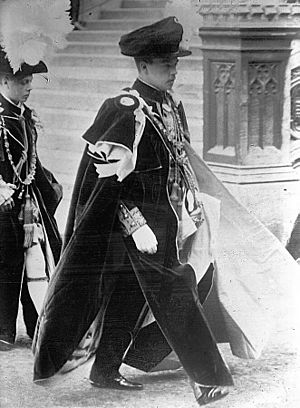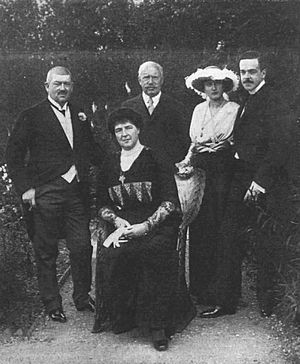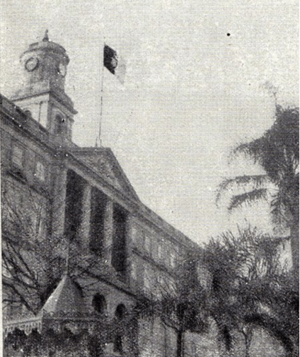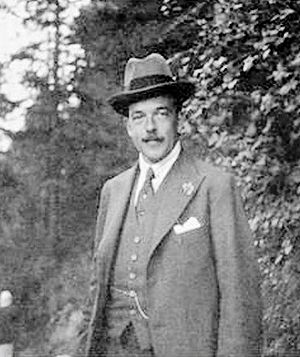Manuel II of Portugal facts for kids
Quick facts for kids Manuel II |
|
|---|---|
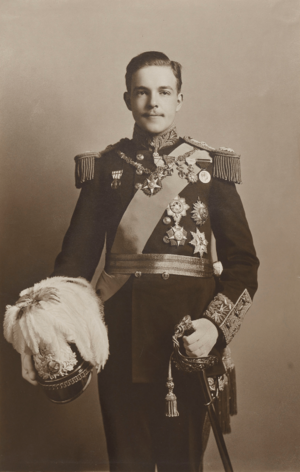
Manuel II, c. 1909
|
|
| King of Portugal | |
| Reign | 1 February 1908 – 5 October 1910 |
| Acclamation | 6 May 1908 |
| Predecessor | Carlos I |
| Successor | Monarchy abolished |
| Prime Ministers |
See list
João Franco
Francisco Ferreira do Amaral Artur Campos Henriques Sebastião Sousa Teles Venceslau de Lima Francisco Veiga Beirão António Teixeira de Sousa |
| Born | 15 November 1889 Belém Palace, Lisbon, Portugal |
| Died | 2 July 1932 (aged 42) Fulwell, Middlesex, England |
| Burial | 2 August 1932 Pantheon of the Braganzas |
| Spouse | |
| House | Braganza-Saxe-Coburg and Gotha |
| Father | Carlos I of Portugal |
| Mother | Amélie of Orléans |
| Religion | Roman Catholicism |
| Signature | |
Manuel II (born November 15, 1889 – died July 2, 1932) was the very last King of Portugal. People called him "the Patriot" or "the Unfortunate". He became king after his father, King Carlos I, and older brother, Luís Filipe, were sadly killed. Before becoming king, he was known as the Duke of Beja. His time as king ended when the monarchy was overthrown during the 5 October 1910 revolution. After that, Manuel lived the rest of his life in exile in Twickenham, England.
Contents
- Manuel's Early Life
- A Tragic Day in Lisbon
- Becoming King of Portugal
- Social Challenges and Changes
- The Revolution Begins
- Manuel's Personal Life
- Life in Exile
- World War I and Manuel's Role
- The Monarchy's Future
- The "Monarchy of the North"
- Manuel's Legacy and Death
- Honors and Awards
- Manuel's Family Tree
- Images for kids
- See also
Manuel's Early Life
Manuel was born in Lisbon, Portugal, in the Palace of Belém. This was less than a month after his father, King Carlos I, became king. Manuel was the third child and second son of King Carlos and Amélie of Orléans.
He was part of the House of Braganza, a royal family. He was baptized a few days after his birth. His grandfather from his mother's side was his godfather. Even the former Emperor Pedro II of Brazil, who was Manuel's great-granduncle, attended the ceremony. Emperor Pedro II had lost his throne in Brazil on the very day Manuel was born.
Manuel received the usual education for a royal family member. Unlike his older brother, who was expected to be king, Manuel didn't have to worry about politics as much. He was raised in a high-class family but became more connected to ordinary people after becoming king. He even stopped many old court traditions. He loved learning history and languages. By age six, he could speak and write French. He really enjoyed reading and literature. This was different from his older brother, who preferred sports. Manuel also learned horse riding, fencing, rowing, tennis, and gardening. He loved music, especially Beethoven and Wagner, and played the piano.
As a child, Manuel played with children from other noble families. In 1902, he started learning Latin and German. Later, he had teachers for Portuguese history, math, French, English, religion, and piano. In 1903, he traveled to Egypt with his mother and brother. They went on the royal yacht Amélia to learn about ancient civilizations. In 1907, he joined the Portuguese Naval Academy.
A Tragic Day in Lisbon
Manuel's plans to join the Portuguese Navy suddenly changed on February 1, 1908. On that day, the royal family was returning to Lisbon from the Ducal Palace in Vila Viçosa. As their carriage passed through the Terreiro do Paço plaza, shots were fired. At least two republican activists, Alfredo Luis da Costa and Manuel Buiça, were involved. It's not clear if they wanted to kill the King, the Prince, or the prime minister. The attackers were immediately shot by the royal guards. They were later identified as members of the Portuguese Republican Party.
King Carlos was killed. Prince Luís Filipe was badly hurt and died about 20 minutes later. Prince Manuel was shot in the arm. Queen Amélie of Orleans was not hurt. It was her quick thinking that helped save her younger son. Days later, Manuel II was declared King of Portugal. The young King was not prepared to rule. He tried to save the royal family's position by firing the prime minister, João Franco, and his government in 1908. However, different political groups had their own goals. This made Manuel's short time as king very difficult. In elections held on August 28, 1910, the republicans only won 14 seats in the government.
Becoming King of Portugal
Manuel's first action as king was to meet with his advisors. He asked João Franco, the prime minister, to resign. Many believed Franco's policies led to the tragedy. Manuel then appointed a new government. This helped calm the republicans for a short time.
On May 6, 1908, he officially opened the Royal Court Assembly. He promised to support the country's laws. People felt a lot of sympathy for the young King because his father and older brother had died. His mother, Queen Amélie, protected him. He also sought advice from an experienced politician, José Luciano de Castro. Manuel decided he would "reign, but not govern." This meant he would be the head of state but let the government make most decisions.
The new King tried to connect more with his people. He visited many parts of the country. His trips included cities like Porto, Braga, and Coimbra. During these visits, people were charmed by the young king. He was welcomed warmly everywhere. On November 23, he traveled to Espinho to open a new railway. He won people over with his honest and kind nature.
However, republicans did not like him. A republican journalist, João Chagas, warned the King: "Your Highness arrives too young into a very old world!"
Social Challenges and Changes
In the 1800s, many thinkers worried about the growth of city workers. This was a result of the Industrial Revolution. In Portugal, this wasn't as big a problem because there was less industry. But an economic crisis made things worse. The Republican Party believed that a republic would solve these problems. This was called the Questão Social (social question).
The Socialist Party had existed since 1875. But it never had a voice in the government. This was partly because it wasn't very popular. Also, the Republican Party was the main group for people who were unhappy with the political system. King Manuel made some moves to encourage the Socialist Party. He hoped this would make them support the republicans less.
In 1909, Manuel invited a French expert, Léon Poinsard, to study Portugal's social situation. Poinsard suggested that local governments needed to be reorganized. This would help fight corruption. The King was excited about this idea. He wrote to the Prime Minister, Wenceslau de Sousa Pereira de Lima. He told him how important it was to work with the Socialists. He hoped this would "empty their supporters from the Republican Party."
The government did try to work with the Socialists. But it was difficult. The Socialists were happy about the King's support. In July 1910, the government created a group to study setting up a "National Work Institute." This group included three socialists. However, the Socialists complained that the group didn't have enough resources. By September, it was too late for the monarchy.
During his reign, Manuel visited many parts of northern Portugal. He also traveled to Spain, France, and the United Kingdom. In November 1909, he was made a Knight of the Order of the Garter in the UK. He kept Portugal's foreign policy close to Great Britain. This was a smart move, as it helped strengthen his position as king. The court also thought that if the King married a British princess, it would protect Portugal. But the country's instability and the death of King Edward VII ended these plans. The British government was not interested in keeping the Portuguese monarchy.
The Revolution Begins
The government became very unstable. Seven different governments were formed and fell in just two years. The parties that supported the monarchy kept breaking apart. Meanwhile, the Republican Party grew stronger. Elections on August 28, 1910, brought 14 new republican representatives. This helped the revolutionary cause. However, the republicans had already decided to take power by force. The killing of a well-known republican started the coup d'état (a sudden takeover of government).
Between October 4 and 5, 1910, the Republican Revolution broke out in Lisbon. It started as a military coup by soldiers. Some civilians and city guards joined in. They attacked loyal army groups and the royal palace. Guns from the cruiser NRP Adamastor also fired. The Palace of Necessidades, where the young King lived, was bombed. This forced Manuel to move to the Mafra National Palace. There, he met his mother, Queen Amélia, and his grandmother, Queen Mother Maria Pia of Savoy. There wasn't much public reaction to these events. Pictures from the plaza where the Republic was declared didn't show a huge crowd. Some military members were even worried their actions wouldn't succeed.
One day later, it was clear that the republicans had taken control. Manuel decided to leave from Ericeira on the royal yacht Amélia IV. He planned to go to Porto. Armed republicans arrived just as the ship left. It's not clear if his advisors changed his mind or if he was forced to change direction. But the Royal Family landed in Gibraltar shortly after. They had heard that Porto had also fallen to the republicans. The coup was complete. The Royal Family went into exile, arriving in the United Kingdom. King George V welcomed them there.
Manuel's Personal Life
In the spring of 1912, Manuel visited Switzerland. There, he met Princess Augusta Victoria of Hohenzollern (1890–1966). She was the daughter of William, Prince of Hohenzollern. Manuel was very impressed by her. They were second cousins, both being great-grandchildren of Maria II. The next year, on September 4, 1913, Manuel married Augusta Victoria.
The wedding ceremony took place in the Chapel of Sigmaringen Castle. Manuel wore his Order of the Garter medallion and the sash of the Three Portuguese Orders. He stood on a box filled with soil brought from Portugal. Cardinal José Sebastião de Almeida Neto, who had baptized Manuel as a young prince, led the ceremony. The Prince of Wales (Edward VIII) and King Alfonso XIII of Spain were also there. Representatives from many European royal families attended. After two days of celebrations, the couple went on their honeymoon to Munich. The marriage was calm and peaceful. It lasted until Manuel's death. They did not have any children.
Life in Exile
In exile, Manuel lived at Fulwell Park in Twickenham, which is now part of London. His mother had been born there. At Fulwell Park, he tried to make it feel like Portugal. Attempts to bring him back to the throne (in 1911, 1912, and 1919) failed. He was active in the local community. He went to church services and became a godfather to several children. In 1932, he gave a special window to St James Church. It showed the Braganza family symbol and St Anthony. This was to celebrate 700 years since the saint's death. Some street names in the area, like Manuel Road and Lisbon Avenue, remind people of him.
He kept up with political events in Portugal. He worried about the chaos of the First Portuguese Republic. He feared it could lead to Spain taking over Portugal and risking the country's independence.
Even in exile, Manuel remained a patriot. He once helped Portugal directly. After a government change in 1926, the new Portuguese ambassador to London was not recognized by the British government. The ambassador needed to discuss Portugal's debt to the United Kingdom. So, the Minister of Foreign Affairs asked Manuel to help. The former king was happy to help his homeland. He spoke with many of his British contacts, including King George V. This helped solve the problem. Manuel even stated in his 1915 will that he wanted to give his possessions to the Portuguese State to create a museum. He also wanted to be buried in Portugal.
World War I and Manuel's Role
Manuel believed Portugal should join World War I and actively participate. He asked monarchists (people who wanted the king back) to stop trying to restore the monarchy while the war was on. He even met with republicans and offered to join the Portuguese army. But most monarchists did not follow his advice. Many supported Germany, hoping a German victory would help bring back the monarchy. Manuel thought that supporting Great Britain would help Portugal keep its overseas colonies. He feared these would be lost to Germany otherwise. None of his close supporters who offered to help the Republic were accepted.
Manuel tried to help the Allied Powers in any way he could. He was disappointed when he was assigned a role in the British Red Cross. But he put all his effort into it. He attended meetings, helped raise money, and visited hospitals and wounded soldiers. This work gave him a lot of satisfaction. His visits to the front lines were difficult for the French government. But his friendship with King George V helped ease their concerns. However, his efforts were often not recognized. Years later, he complained, "The operating room in the Portuguese Hospital in Paris, during the War, was built by me. Do you know what they put on the plaque? 'From a Portuguese in London'." The King also helped create the Orthopedic Department at Shepherd's Bush Hospital. It continued to treat war injuries until 1925 because of his insistence. King George V showed his appreciation by inviting Manuel to the victory celebrations in 1919.
The Monarchy's Future
Since 1911, Portuguese monarchists in exile gathered in Galicia, Spain. They wanted to enter Portugal and bring back the monarchy. But the Spanish government didn't openly approve. These monarchists were led by Henrique Mitchell de Paiva Couceiro. He believed that a show of force would make people in the countryside rise up and support the monarchy. But he was wrong. His forces were not well prepared or funded. People in the countryside didn't care, and the attempts ended with retreats back into Galicia.
Manuel supported these efforts as best he could, but he didn't have much money. He also faced a problem: some monarchists didn't fully support his claim to the throne. One attack used a flag without the crown. Paiva Couceiro himself once said his movement was "neutral." He wanted people to vote on the new government. Only after Manuel exchanged letters with Couceiro did the King support the Galician monarchists. They promised to support the old laws. The second attempt in 1912 was better planned. But it failed because the Spanish government had to stop the monarchist camps in Galicia. Manuel was never able to restore his kingdom by force. He always believed monarchists should work legally through elections. But many militant monarchists disagreed. They continued their poorly planned attempts to bring back the monarchy, causing chaos. Manuel worried that Portugal's instability might make the United Kingdom ally with Spain. He feared Spain might try to take over Portugal.
The "Monarchy of the North"
Some monarchists continued their efforts during the war. But the former King kept telling them to stop. He urged them to restore the monarchy through elections. This seemed possible after a new government in January 1915. It removed some restrictions on monarchist groups. Between April and May 1915, 55 monarchist centers opened. This made many republicans unite. On May 14, 1915, revolution returned to the streets. After three days of fighting, with many deaths and injuries, the republican party regained control. Monarchist groups were again made illegal.
Manuel continued to ask for calm at the end of the war. He insisted on waiting until peace talks in Paris were over. He worried that continued chaos in Portugal would hurt its position in negotiations. But for Paiva Couceiro and other monarchists, this was the moment. On January 19, 1919, a thousand soldiers and some artillery, led by Paiva Couceiro, took over Porto. They wanted to bring back the monarchy and King Manuel II. A temporary government was set up. It controlled parts of northern Portugal. But, unlike Couceiro's hopes, the rest of the country did not rise up.
In Lisbon, the monarchists were surprised. They were surrounded by republican forces and surrendered on January 24. With the failure in the center and south, Paiva Couceiro's luck ran out. On February 13, part of the Republican National Guard deserted. They restored the Republic in Porto. Monarchists who didn't escape were jailed. The King, in exile, only learned of the failure by reading newspapers.
Manuel's Legacy and Death
Manuel was always a keen reader. During his exile, he studied literature. He wrote about Medieval and Renaissance literature in Portugal. After World War I, he had more free time. He focused on these studies, a love he inherited from his father. He was interested in writing a biography of Manuel I of Portugal. He believed other historians had treated him unfairly. He hired a book expert in 1919 to find old books for his project. He was helped by many private collections being sold after the Republic was established.
By 1926, Manuel decided to focus on describing the old books in his own library. This was more than just a list. It allowed Manuel to write about Portugal's past glories. He wrote not just a bibliography but also about the authors and their times. His work was very detailed and showed his love for Portugal. The first volume of his work, Livros Antigos Portuguezes 1489–1600, was published in 1929. Manuel personally gave a copy to his friend King George V at Windsor Castle. The work was well received. The King started on the second volume. But the project ended too soon in 1932 when Manuel died unexpectedly. The third volume was published after his death. His completed works earned him respect among Portuguese historians. His statue was even placed at the entrance of the National Library in Lisbon.
King Manuel died suddenly at his home on July 2, 1932. He suffocated due to swelling in his throat. The Portuguese government, led by António Oliveira de Salazar, allowed him to be buried in Lisbon. His body arrived in Lisbon on August 2, 1932, on a British ship. The ship sailed into the Tagus River to deliver the coffin. A large crowd gathered at Praça do Comércio to follow the coffin to São Vicente de Fora. The streets were filled with people wanting to see the funeral procession. His body was buried in the Royal Pantheon of the House of Braganza.
People gave him several nicknames. He was called O Patriota ('The Patriot') because he cared so much about Portugal's identity. He was also called O Desventurado ('The Unfortunate') because he lost his throne. And O Estudioso or O Bibliófilo ('The Studious' or 'The Bibliophile') for his love of Portuguese literature. Monarchists also called him O Rei-Saudade ('The Missed King'). This was because they longed for the monarchy after it was abolished.
Some people found his death suspicious. He had been playing tennis the day before and seemed very healthy. A former police officer mentioned an incident in his book. In 1931, an intruder was found at Fulwell Park. The police said he was a member of a Portuguese republican group and sent him back to Lisbon. The reason for his intrusion is still unknown.
After King Manuel's death, there was no direct heir to the throne. Manuel had made it clear that the Portuguese royal family would end with him. However, in 1932, a monarchist movement supported Duarte Nuno, Duke of Braganza as King of Portugal.
After King Manuel's death, the Portuguese government allowed the return of the exiled Braganza family branch in 1950. This reversed old laws of exile. Also, with the sale of the King's English estate and some of his belongings, the Foundation of the House of Braganza was created. This was according to King Manuel's wish to leave his personal wealth to the Portuguese people.
Honors and Awards
Manuel II received many honors during his life.
From Portugal
- Grand Cross of the Sash of the Two Orders
- Gold Medal of the Royal Humanitarian Society of Porto
He became the head of all Portuguese orders when he became king.
From Other Countries

 Austria-Hungary:
Austria-Hungary:
- Gold Jubilee Court Medal, 1898
- Grand Cross of the Royal Hungarian Order of St. Stephen, 1909
 United Kingdom:
United Kingdom:
- Honorary Grand Cross of the Royal Victorian Order, 1904
- Stranger Knight of the Garter, 1909
- Commemorative Medal for the Coronation of King George V, 1911
- British War Medal (1914-1918), 1919
 France:
France:
 Sovereign Military Order of Malta: Bailiff Grand Cross of Honour and Devotion, 1907
Sovereign Military Order of Malta: Bailiff Grand Cross of Honour and Devotion, 1907 Holy See: Grand Cross of the Holy Sepulchre of Jerusalem, 1908
Holy See: Grand Cross of the Holy Sepulchre of Jerusalem, 1908 Spain:
Spain:
- Knight of the Golden Fleece, 1908
- Grand Cross of the Order of Charles III, 1909
 Russian Empire:
Russian Empire:
- Knight of St. Andrew, 1908
- Knight of St. Alexander Nevsky, 1908
- Knight of the White Eagle, 1908
- Knight of St. Anna, 1st Class, 1908
- Knight of St. Stanislaus, 1st Class, 1908
 Kingdom of Italy:
Kingdom of Italy:
- Knight of the Annunciation, 1908
- Gold Medal of Merit for the Messina Earthquake, 1908
 Belgium:
Belgium:
- Grand Cross of the Order of Leopold (military), 1908
 German Empire:
German Empire:
- Knight of the Black Eagle, 1908
- Grand Cross of the Red Eagle, 1908
 Netherlands: Grand Cross of the Netherlands Lion, 1908
Netherlands: Grand Cross of the Netherlands Lion, 1908 Kingdom of Romania: Grand Cross of the Order of Carol I, 1908
Kingdom of Romania: Grand Cross of the Order of Carol I, 1908 Sweden: Knight of the Seraphim, 1909
Sweden: Knight of the Seraphim, 1909 Denmark: Knight of the Elephant, 1909
Denmark: Knight of the Elephant, 1909 Monaco: Grand Cross of St. Charles, 1909
Monaco: Grand Cross of St. Charles, 1909 Norway: Grand Cross of St. Olav, with Collar, 1909
Norway: Grand Cross of St. Olav, with Collar, 1909 Empire of Japan: Grand Cordon of the Order of the Chrysanthemum
Empire of Japan: Grand Cordon of the Order of the Chrysanthemum
Manuel's Family Tree
| Ancestors of Manuel II of Portugal | |||||||||||||||||||||||||||||||||||||||||||||||||||||||||||||||||||||||||||||||||||||||||||||||||||||||||||||||||||||||||||||||||||||||||||||||||||||||||||||||||||||||||||||||||||||||||||||||||||||||||||||||||||||||||||||||||||||||||||||||||||||||||||||||||||||||||||||||||||||||||
|---|---|---|---|---|---|---|---|---|---|---|---|---|---|---|---|---|---|---|---|---|---|---|---|---|---|---|---|---|---|---|---|---|---|---|---|---|---|---|---|---|---|---|---|---|---|---|---|---|---|---|---|---|---|---|---|---|---|---|---|---|---|---|---|---|---|---|---|---|---|---|---|---|---|---|---|---|---|---|---|---|---|---|---|---|---|---|---|---|---|---|---|---|---|---|---|---|---|---|---|---|---|---|---|---|---|---|---|---|---|---|---|---|---|---|---|---|---|---|---|---|---|---|---|---|---|---|---|---|---|---|---|---|---|---|---|---|---|---|---|---|---|---|---|---|---|---|---|---|---|---|---|---|---|---|---|---|---|---|---|---|---|---|---|---|---|---|---|---|---|---|---|---|---|---|---|---|---|---|---|---|---|---|---|---|---|---|---|---|---|---|---|---|---|---|---|---|---|---|---|---|---|---|---|---|---|---|---|---|---|---|---|---|---|---|---|---|---|---|---|---|---|---|---|---|---|---|---|---|---|---|---|---|---|---|---|---|---|---|---|---|---|---|---|---|---|---|---|---|---|---|---|---|---|---|---|---|---|---|---|---|---|---|---|---|---|---|---|---|---|---|---|---|---|---|---|---|---|---|---|---|---|
|
|||||||||||||||||||||||||||||||||||||||||||||||||||||||||||||||||||||||||||||||||||||||||||||||||||||||||||||||||||||||||||||||||||||||||||||||||||||||||||||||||||||||||||||||||||||||||||||||||||||||||||||||||||||||||||||||||||||||||||||||||||||||||||||||||||||||||||||||||||||||||
Images for kids
See also
 In Spanish: Manuel II de Portugal para niños
In Spanish: Manuel II de Portugal para niños


